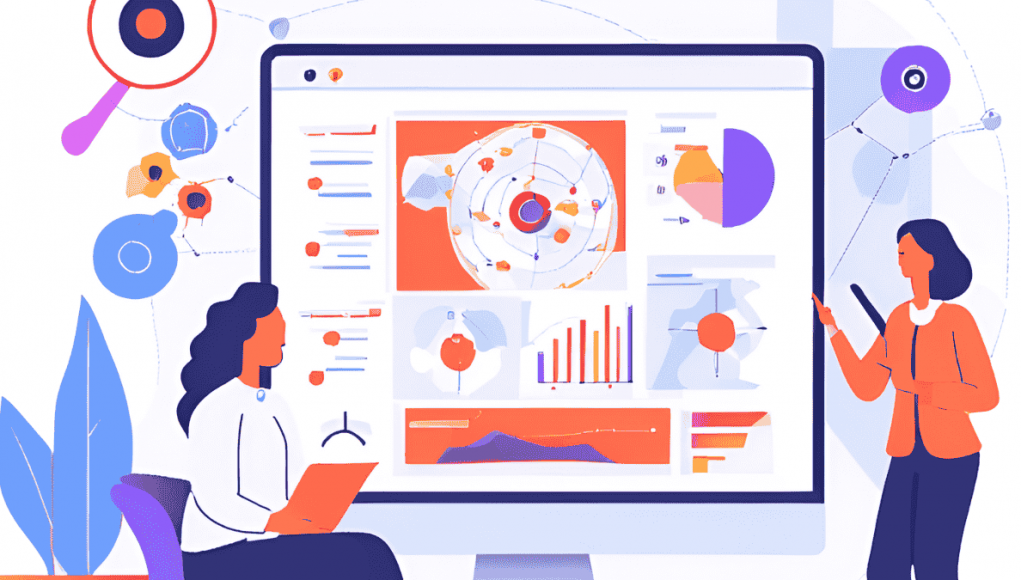In today’s fast-paced digital marketing landscape, effective ad targeting is crucial for maximizing campaign success. Businesses are increasingly turning to AI tools for ad targeting to boost precision, enhance audience segmentation, and improve return on investment (ROI). By leveraging advanced machine learning algorithms, these tools help advertisers pinpoint their ideal audience, ensuring ads are seen by the right people at the right time.
With the rise of artificial intelligence, AI-driven ad targeting tools offer unprecedented insights into user behavior and preferences. These tools analyze vast amounts of data, helping marketers refine their strategies and deliver personalized ads that resonate with potential customers. In this article, we’ll explore the importance of AI tools in ad targeting and introduce the 15 best options available to enhance your marketing efforts.
Why Are AI Tools for Ad Targeting Important?
- Precision Targeting: AI tools analyze user data to deliver ads to the right audience based on behavior, interests, and demographics.
- Cost Efficiency: They help optimize ad spend by ensuring your budget targets high-converting prospects.
- Real-Time Adjustments: AI tools continuously learn from campaign performance and adjust in real-time for better outcomes.
- Scalability: AI enables automated, large-scale ad campaigns with minimal human intervention.
- Personalization: They create personalized ad experiences that resonate deeply with individual users, increasing engagement.
15 Best AI Tools for Ad Targeting
To optimize your ad campaigns and achieve better results, here are 15 of the best AI tools that can transform your ad targeting efforts.
1. AdCreative.ai
AdCreative.ai is an AI-driven platform designed to generate high-conversion ad creatives for digital marketers. It focuses on optimizing advertising campaigns across various platforms, such as social media and display networks, to maximize engagement and ROI.
Features
- AI-generated social media and video ads, personalized based on brand color schemes and past performance.
- AI-generated headlines to improve click-through rates (CTR) and engagement.
- Tailored video ad creation for different platforms, optimizing the format and style for each target.
- Ad library with competitor analysis and performance insights to help improve future campaigns.
- AI model learns your brand identity, including fonts and color palette, ensuring a cohesive design.
Pros
- Easy to use with minimal design experience required.
- Improves engagement and conversions by leveraging data-driven insights.
- Ensures consistent branding across multiple campaigns.
- Saves time by automating the creative generation process.
Cons
- Limited customization options for advanced users.
- May not scale efficiently for larger enterprises with complex campaign needs.
2. Jasper.ai
Jasper.ai is a comprehensive AI marketing platform known for content creation and ad copywriting. Originally designed as an AI writing assistant, it has since evolved into a robust marketing tool with capabilities for generating high-quality campaign content, social media posts, and ad creatives.
Features
- Over 50 templates for writing high-conversion content, including ad copy, blog posts, emails, and social media updates.
- Content remixing capabilities to generate new variations of existing material, which is ideal for ad testing and optimization.
- AI-generated social media content for multiple platforms like Facebook, Instagram, and LinkedIn.
- Integration with popular tools like Google Docs, Shopify, HubSpot, and Notion, allowing seamless workflows across multiple platforms.
- Customization of tone and style to ensure all content aligns with your brand voice.
- Chrome extension for quick content creation and optimization on the go.
Pros
- Versatile, allowing users to create content across multiple channels.
- Collaborative tools for team-based projects, making it easy to share and review content.
- Scales well for businesses of different sizes and industries.
- Increases efficiency in creating large volumes of content.
Cons
- New users might experience a learning curve due to the wide range of features.
- Limited in design capabilities; focused more on copywriting than visual content.
3. MadgicX
MadgicX is an AI-powered platform built for optimizing digital advertising campaigns. It offers precise audience targeting and detailed performance analysis for marketers, helping to refine ad strategies across multiple platforms, such as Facebook and Google Ads.
Features
- AI-powered audience targeting based on user behavior, past engagements, and interests, identifying high-value segments.
- Creative intelligence tools to assess and optimize the performance of ad creatives, providing recommendations on which elements drive the most engagement.
- Autonomous ad buying, which dynamically adjusts targeting and budget allocation based on real-time performance data.
- Omnichannel support, managing ad campaigns across Facebook, Google, and Instagram from a single platform.
- Predictive analytics that estimate potential ad performance before spending on them.
Pros
- Highly accurate targeting through data-driven insights and AI modeling.
- Automates real-time adjustments to campaigns, improving overall ROI.
- Omnichannel capabilities allow for seamless management across multiple ad platforms.
- Time-saving through automation of ad buying and performance tracking.
Cons
- The interface can be complex for beginners or small businesses.
- Higher cost, making it more suitable for businesses with larger budgets and advanced needs.
4. GumGum
GumGum is an AI-powered advertising platform specializing in contextual ad targeting. Its primary focus is ensuring ads appear in the right context for the audience by using its proprietary Verity platform, which analyzes the content of web pages to match ads with the most relevant and appropriate environments.
Features
- Verity’s contextual intelligence analyzes web page content using natural language processing (NLP) and computer vision to display ads in relevant and brand-safe environments.
- AI-driven in-image and in-video ads, where ads are embedded within the content for a more seamless user experience.
- Brand safety is prioritized through automated scanning that ensures ads are not placed next to inappropriate content.
- Proprietary AI adapts to changing content and ensures consistent ad performance in real-time.
- Accredited by the Media Rating Council (MRC) for brand safety and contextual analysis.
Pros
- Highly accurate in placing ads within appropriate and relevant content environments.
- Non-intrusive ad formats, such as in-image and in-video ads, which enhance user experience.
- Brand safety is a priority, with AI ensuring ads appear in suitable contexts.
- Reduces the risk of brand damage from inappropriate ad placements.
Cons
- Limited control for advertisers over ad placements, as the AI handles most decisions.
- Higher costs may make it less accessible for smaller businesses.
5. Basis Technologies
Basis Technologies is an AI-driven platform focused on optimizing programmatic advertising. Formerly known as Centro, it automates media buying, campaign management, and bidding strategies across digital channels such as search, social, and display.
Features
- Predictive modeling powered by AI to forecast campaign performance and optimize ad bidding.
- Cross-channel campaign management, supporting programmatic, search, social, and publisher-direct advertising from a single platform.
- Automated media buying that dynamically adjusts bids and ad placements in real-time.
- AI-driven audience segmentation based on behavioral and demographic data, refining ad targeting.
- Real-time optimization to reallocate budgets and tweak targeting for better results based on performance.
Pros
- Seamless cross-channel management, consolidating campaigns across multiple ad platforms.
- Real-time campaign adjustments, ensuring optimal performance with minimal manual intervention.
- Reduces complexity by automating media buying and bidding strategies.
- Scalable for large enterprises with complex advertising needs.
Cons
- High cost for smaller businesses or startups.
- Requires a strong understanding of digital marketing to utilize fully.
6. Superside
Superside is an AI-enhanced creative service platform designed to help businesses generate high-quality ad creatives at scale. Unlike typical ad-generating tools, Superside offers a subscription model, allowing clients to access a dedicated creative team that uses AI to streamline the creative process.
Features
- AI-enhanced creative services, including 2D and 3D illustrations, micro-animations, and video production.
- AI helps manage and expand brand libraries, ensuring new creative assets align with the brand’s identity.
- Rapid prototyping, allowing creative drafts to be generated quickly for review and iteration.
- Subscription-based model, providing access to a dedicated creative team without needing full-time hires.
- Covers all aspects of ad production, including copywriting, design, and animation.
Pros
- AI assists in delivering high-quality creatives efficiently, reducing turnaround times.
- Predictable costs with a monthly subscription model.
- Diverse ad formats and creative outputs, from static designs to complex animations.
- Provides ongoing creative support for companies with high-volume ad needs.
Cons
- High starting price, making it suitable mostly for larger companies.
- Less flexibility for highly custom or niche creative needs, as creative teams handle much of the design process.
7. Narrato
Narrato is an AI-powered content management and creation platform that helps businesses generate and manage various types of marketing content. It’s ideal for streamlining editorial workflows, planning content, and generating ad copy, blog posts, and social media content. Narrato is designed to support marketing teams in improving productivity and maintaining consistency in their content creation efforts.
Features
- AI-powered content generation for blogs, social media posts, and ad copy, with SEO optimization built into the creation process.
- AI content brief generator that provides detailed instructions and outlines for content creators to follow, ensuring quality and relevance.
- Custom ad templates tailored for creating ad copy that resonates with different target audiences.
- AI-generated images and graphics to accompany written content, helping businesses create visually appealing posts.
- Automated content scheduling, allowing marketers to plan and publish their content across various platforms efficiently.
Pros
- Saves time by automating both content creation and content planning.
- Optimized for SEO, which can help improve search engine rankings.
- Provides a simple and efficient way to generate professional ad copy.
- Integrates collaborative tools for teams, helping with task management and workflow coordination.
Cons
- Primarily focused on content creation, with fewer advanced tools for ad targeting.
- Limited customization options for the AI-generated images and graphics.
8. Creatify
Creatify is an AI-powered video ad creation platform that simplifies the production of short-form video ads for social media and digital marketing. By converting product URLs or brief descriptions into engaging video content, Creatify makes it easy for businesses to create professional-quality video ads with minimal effort.
Features
- Automatically generates video ads from product URLs, making it easy to create video content without prior video production skills.
- AI avatars that can be customized to interact with audiences, providing a human-like touch to video content.
- Script generation and text-to-speech functionality for voiceovers, eliminating the need for professional voice talent.
- Batch mode, which allows businesses to generate multiple ads simultaneously, saving time for those managing large campaigns.
- Video customization options, including the ability to change backgrounds, add text overlays, and include animations to enhance ad effectiveness.
Pros
- Quick and efficient video creation from simple product links.
- Customizable video content, ensuring that the ads fit a brand’s look and feel.
- Time-saving batch mode for creating multiple ads at once.
- Ideal for businesses focused on social media advertising.
Cons
- Limited creative control for users looking to make advanced video edits.
- Primarily designed for short-form video content, so it may not be suitable for more extensive video production needs.
9. InVideo
InVideo is an AI-powered video creation platform that allows users to create professional-looking video ads with minimal effort. It automates the process of turning scripts into videos, making it accessible for those without prior video production experience. The tool is popular among content creators, social media marketers, and small businesses looking to create engaging video content quickly.
Features
- Text-to-video functionality that converts written scripts into video, automatically adding visuals, music, subtitles, and voiceovers.
- AI-generated templates tailored to different industries, allowing users to create professional-quality videos without needing to start from scratch.
- Faceless video generator for creating explainer videos, product demos, and tutorials without the need for human actors.
- AI talking avatar feature, where virtual presenters can be added to videos to enhance the message delivery.
- Automated subtitle and voiceover generation, adding a polished finish to video content.
Pros
- Very easy to use, making video creation accessible to beginners.
- Offers a wide range of templates that can be customized for various industries.
- Comprehensive features, including voiceovers, avatars, and subtitles, provide a professional touch to videos.
- Ideal for small and medium businesses creating social media ads.
Cons
- Limited in terms of advanced video editing features for more experienced users.
- Some features are locked behind a subscription, which could be a barrier for smaller budgets.
10. Flick
Flick is an AI-powered platform designed to optimize social media content creation, with a focus on hashtag management, post scheduling, and ad creative generation. It helps businesses, content creators, and social media managers increase engagement by using AI-driven suggestions and performance analytics to refine their social media strategies.
Features
- AI-generated content ideas based on current trends, helping users create engaging posts and ad creatives.
- Advanced hashtag optimization, which suggests the best-performing hashtags to increase visibility and engagement on Instagram and TikTok.
- Post scheduling tools that allow users to plan and automate social media posts in advance.
- AI-generated captions to complement social media posts, saving time for marketers and content creators.
- In-depth analytics that tracks hashtag performance and overall post success, helping users refine their strategies.
Pros
- Time-saving tools for planning and scheduling social media content.
- Effective hashtag strategy improves post visibility and engagement.
- AI-generated captions and content ideas make content creation easier.
- Offers detailed analytics to track and improve performance.
Cons
- Primarily focused on Instagram and TikTok, limiting its usefulness for businesses heavily relying on other platforms like Facebook or Twitter.
- Limited in terms of advanced design tools for ad creatives.
11. Albert AI
Albert AI is a marketing automation platform that uses machine learning to manage and optimize digital ad campaigns across multiple channels. It specializes in personalizing campaigns, optimizing ad spend, and improving overall marketing performance by learning from real-time data and making adjustments accordingly.
Features
- Cross-channel optimization that manages and automates campaigns across platforms like Facebook, Google, and YouTube.
- Real-time decision-making to adjust campaigns, budgets, and targeting based on performance data.
- Advanced audience segmentation based on user behavior, allowing more targeted and effective campaigns.
- Machine learning algorithms that continually learn from campaign performance to improve targeting and ROI.
- Seamless integration with marketing tools, ensuring smooth data flow and campaign management.
Pros
- Automates the optimization of campaigns across multiple channels, reducing manual work.
- Continuously improves targeting and campaign effectiveness using real-time data.
- Detailed audience segmentation ensures personalized campaigns.
- Integrates smoothly with existing marketing technology stacks.
Cons
- Requires technical expertise and a solid understanding of digital marketing strategies.
- Lack of transparency in how AI makes certain campaign decisions, which can be challenging for marketers who want full control.
12. HubSpot AI
HubSpot AI is integrated within HubSpot’s larger marketing suite and helps businesses optimize their campaigns, audience segmentation, and ad targeting. It uses AI to streamline marketing efforts and ensure that the right message reaches the right audience at the right time.
Features
- AI-driven segmentation helps businesses automatically create audience groups based on behavior, demographics, and interactions.
- Smart content recommendations suggest the most effective content for specific audiences.
- Automated A/B testing allows businesses to optimize ad performance by analyzing different variations and choosing the best one.
- Integrated with HubSpot CRM, allowing for unified tracking of customer interactions and ad campaign performance.
- Recommendations for bid adjustments and budget optimization to improve campaign ROI.
Pros
- Seamlessly integrated with HubSpot’s CRM, providing a comprehensive marketing solution.
- User-friendly, making it accessible for small to mid-sized businesses.
- AI-driven insights help optimize audience targeting and campaign effectiveness.
- Smart content recommendations improve engagement and conversion rates.
Cons
- Limited advanced features compared to standalone AI advertising tools.
- Most AI benefits are tied to the HubSpot ecosystem, making it less suitable for businesses using different platforms.
13. Skai
Skai is an omnichannel advertising platform that uses AI to optimize ad targeting and performance across multiple digital channels, including social media, search engines, and display networks. Its predictive analytics and AI-driven insights help marketers refine their ad strategies for better results.
Features
- Omnichannel optimization for managing campaigns across social media, search engines, and other digital channels.
- AI-driven audience insights that help advertisers identify new segments based on behavioral data and interactions.
- Automated bidding and budget allocation to improve ad performance.
- Predictive analytics for forecasting campaign success based on historical data and trends.
- Unified reporting to track KPIs across multiple platforms in one place.
Pros
- Seamlessly manages ads across multiple channels, making it ideal for omnichannel marketing strategies.
- Actionable insights from AI-driven analytics improve targeting and performance.
- Real-time bidding and budget adjustments maximize campaign ROI.
- Scalable solution for businesses managing large volumes of ads.
Cons
- Complex platform that may require a deeper understanding of digital marketing strategies.
- Expensive, making it better suited for larger businesses and enterprises.
14. ChatFuel
ChatFuel is an AI-powered tool designed for creating chatbots that automate conversations on Facebook Messenger. It allows businesses to set up automated interactions with customers, handle inquiries, and generate leads without needing to write code.
Features
- Drag-and-drop interface for building custom chatbots without coding experience.
- AI-driven chatbot flows that can handle customer inquiries, FAQs, and lead generation.
- Facebook Messenger integration allows businesses to engage with customers directly through automated conversations.
- Customizable conversation flows that can adapt based on user input and engagement.
- Data integration with CRMs for better lead management and follow-up.
Pros
- Easy to set up and deploy with no coding skills required.
- Automates customer support and lead generation, improving efficiency.
- Affordable for small and mid-sized businesses with pricing starting at $14 per month.
- Enhances customer engagement through Facebook Messenger platform with automatic responses and conversation flows.
Cons
- Limited to Facebook Messenger, which may not work for businesses reliant on other platforms.
- Basic AI capabilities may struggle with more complex customer conversations.
15. Phrasee
Phrasee is an AI-powered tool specifically designed to optimize ad copy and marketing language for email campaigns, social media, and paid digital ads. Its main goal is to help businesses create engaging, on-brand messaging that resonates with their target audience and improves conversion rates. Phrasee uses natural language generation (NLG) to craft ad copy, email subject lines, and social media content that are optimized for engagement and conversion.
Features
- AI-powered ad copy generation that ensures messaging is optimized for various digital platforms, from social media posts to email subject lines.
- Natural language generation (NLG) technology that creates human-like language, maintaining brand tone and style throughout.
- Automated email subject line testing, providing insights into what types of headlines drive the most opens and conversions.
- Real-time performance analytics that help businesses track and adjust messaging to improve engagement over time.
- Multichannel support, allowing marketers to deploy consistent copy across email, social media, and digital ads without having to manually rewrite or adjust each format.
Pros
- Improves engagement by optimizing ad copy and email subject lines through AI-driven insights.
- Helps maintain brand consistency across all messaging platforms, ensuring a cohesive voice.
- Saves time for marketing teams by automating the creation of effective, conversion-optimized copy.
- Easy integration with existing marketing platforms, including popular email service providers and ad management tools.
Cons
- Primarily focused on text-based content, so it may not provide as much value for teams needing more robust visual or design features.
- May require some setup and fine-tuning to align with a business’s specific tone and brand voice preferences.
Conclusion
Incorporating AI tools for ad targeting into your marketing strategy is essential for staying ahead in today’s competitive digital landscape. These tools offer precise targeting, real-time optimization, and cost-effective solutions, helping businesses reach the right audience with personalized ads that drive higher conversions. Investing in the right AI tools is a smart move for any business looking to maximize the efficiency of their ad campaigns and achieve sustainable growth.customer





